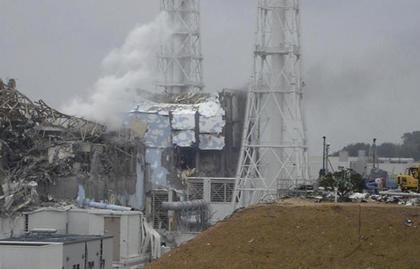Emergency crews dump seawater on spent fuel pool, reducing temperatures
© Tokyo Electric Power via AP
Fukushima, Japan - Workers reconnected power lines to all six reactor units at Japan's radiation-leaking nuclear plant Tuesday, its operator said, marking a significant step in bringing the overheated complex under control.
In making an announcement after days of anxious waiting by the public, Tokyo Electric Power Co. cautioned that much work needed to be done before the electricity can be turned on. Workers are checking all additional equipment for damage to make sure cooling systems can be safely operated, Tokyo Electric said.
In another advance, emergency crews dumped 18 tons of seawater into nearly boiling storage pool holding spent nuclear fuel, cooling it to 105 degrees Fahrenheit, Japan's nuclear safety agency said. Steam, possibly carrying radioactive elements, had been rising for two days, and the move lessens the chances that more radiation will seep into the air.
The power lines and the sustained dousing together mean authorities are closer to bringing the Fukushima Dai-ichi nuclear complex, with its six reactors and spent fuel pools, under control. Officials and experts, however, have said days, even weeks would be needed to replace damaged equipment and vent any volatile gas to make sure electricity does not spark an explosion.
No-man's landEarlier, Japan said there was no need to extend a 12-mile evacuation zone around its tsunami-damaged nuclear plant, despite elevated radiation readings outside the area.
More than 170,000 people have been moved out of the zone, a virtual no-man's land, since an earthquake and 30-ft tsunami smashed into the Fukushima Dai-ichi nuclear power complex on March 11.
"At the moment, there is no need to expand the evacuation area," Chief Cabinet Secretary Yukio Edano told a briefing.
The latest available readings from an area six miles outside the evacuation zone show a level of 110 microsieverts per hour in the air, well below a level that would cause health risks but much higher than normal background levels.
It is unclear what background levels would have been this far away from the plant before the tsunami struck, but a reading of 110 microsieverts is roughly 3,000 times Tokyo's normal pre-disaster background level.
Exposure to 100,000 microsieverts a year is the lowest level at which any increase in cancer risk is clearly evident.
The government is advising people living within six miles of the evacuation zone to stay indoors, but radiation in the atmosphere is not the only problem for these people with some food and even tap water having been found to be contaminated.
Elevated levels of radioactive cesium particles in the air are causing particular concern, because cesium can linger longer than, say, radioactive iodine, another element that has been found not only in the atmosphere but also in tap water.
Edano said there were no health risks, even at the highest cesium readings.
The Vienna-based International Atomic Energy Agency said that radiation seeping into the environment is a concern and needs to be monitored. "We are still in an accident that is still in a very serious situation," said Graham Andrew, senior adviser to IAEA chief Yukiya Amano.
Tainted foodRadiation fears are reaching well beyond those living near Fukushima and the 430,000 displaced by the earthquake and tsunami to encompass large segments of Japan. Traces of radiation are being found in vegetables and raw milk from a swath of farmland, forcing a government ban on sales from those areas.
China, Japan's largest trading partner, has ordered testing of imports of Japanese food. The World Health Organization has urged Japan to adopt stricter measures and reassure the public.
Government officials and health experts say the doses are low and not a threat to human health unless the tainted products are consumed in abnormally excessive quantities. But the government measures to release data on radiation amounts, halt sales of some foods and test others are feeding public worries that the situation may grow more dire.
People at Fukushima city's main evacuation center waited in long lines for bowls of hot noodle soup. A truck delivered toilet paper and blankets. Many among the 1,400 people living in the crowded gymnasium came from communities near the nuclear plant and worry about radiation and weary of the daily routine of the displaced.
"It was an act of God," said Yoshihiro Amano, a grocery store owner whose house is 4 miles from the reactors. "It won't help anything to get angry. But we are worried. We don't know if it will takes days, months or decades to go home. Maybe never. We are just starting to be able to think ahead to that."
The Associated Press and Reuters contributed to this report.
Reader Comments
to our Newsletter